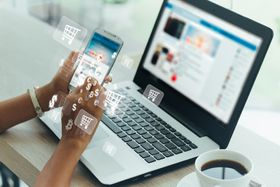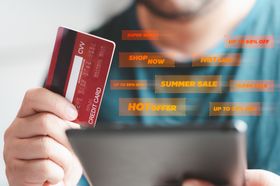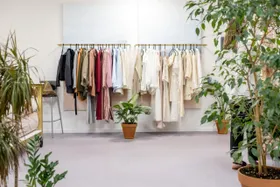Increase Sales With Advanced Visual Merchandising
Advanced visual merchandising is vital for capturing consumer attention and driving sales. By using design elements and technology, you can create immersive experiences that boost engagement and conversions.
Published September 25, 2024

A study published in the International Journal of Research in Business and Social Science found that effective visual merchandising significantly impacts consumer behavior. It identified a positive and significant relationship between store layout, product display, and consumer purchasing intention.
The study revealed that 91.3% of the variance in consumer purchase intentions could be explained by visual merchandising elements. This data underscores the crucial role that visual merchandising plays in influencing consumer behavior and driving sales in fashion retail environments.
Meet the Expert
Arjel Vajvoda, Head of Product at Motomtech, leverages her extensive experience in customer support to craft user-focused SaaS products with innovative documentation solutions.
Benefits of Visual Merchandising on Consumer Behavior
Enhanced brand perception: Visual merchandising effectively conveys a brand's identity through consistent design elements, strengthening brand recognition and loyalty.
Increased impulse purchases: Products placed at eye level or in prominent spots like the end of aisles are more likely to be noticed and purchased. The same principle applies to online stores that place particular products where consumers are guaranteed to see them.
Improved customer experience: A thoughtfully designed store layout that uses visual cues to guide customers can enhance the shopping experience.
Product visibility and focus: By highlighting specific products through lighting, placement, and design, visual merchandising ensures that key items receive the attention they deserve.
Emotional engagement: Visual elements such as color psychology, lighting, and thematic displays can invoke emotions that influence purchasing decisions.
» Need more examples? Here are some inspiring digital merchandising examples
1. Optimized Website Layout and Navigation
This technique is great for all eCommerce businesses, especially those with large product catalogs like online department stores, fashion retailers, or electronics stores.
» Run a fashion store? See our guide to visual merchandising for fashion eCommerce
Key Features for an Optimized Website Layout and Navigation
Best Practices
- Analyze user behavior: Analyze your users' behavior to understand how customers navigate your site, and use this data to design a layout that meets their needs.
- Simplify navigation menus: Ensure that your navigation menus are straightforward, with clear labels and a logical organization.
Costs
Implementing an optimized website layout can cost between $5,000 and $30,000 initially, with monthly maintenance ranging from $1,000 to $5,000.
Success Metrics
- Bounce rate: Aim for below 40%.
- Average session duration: Aim for over 2 minutes.
- Conversion rate: Aim for 2-3% or higher.
Common Challenges
- Creating an intuitive layout: Designing a visually appealing layout can be challenging, especially for businesses with a large number of products.
- Ongoing maintenance: As your business grows or product lines change, updating the website layout to maintain ease of navigation requires continuous effort and resources.
Example: Apple
Apple’s website features a clean and intuitive layout with easy navigation, helping users find products effortlessly. The clear structure and prominent product displays have contributed to Apple’s high online sales and conversion rates.
» Learn more about enhancing eCommerce site search
2. Dynamic Display Designs With Interactive Elements
This technique is ideal for mid-sized to large eCommerce businesses, especially those in fashion, electronics, or home decor. These businesses benefit most from dynamic content displays because they can showcase their products in an engaging way.
Key Features for Dynamic Display Designs
Best Practices
- Optimize for performance: Use lightweight code and compress and optimize images and videos to ensure dynamic content loads quickly, providing a smooth user experience.
- Regularly test interactive elements: Ensure that interactive elements work seamlessly across different devices and browsers, maintaining a consistent experience for all users.
Costs
Implementing dynamic displays with interactive elements can cost between $10,000 and $50,000 initially, with ongoing maintenance and updates ranging from $1,500 to $5,000 per month.
Success Metrics
- Engagement metrics: Aim for a 20% increase in time on site.
- Conversion rates: Aim for a 15% improvement
Common Challenges
- Technical complexity: Implementing interactive elements can be technically complex, requiring expertise that some businesses may lack.
- Site performance issues: Adding dynamic and interactive content can slow down page load times if not optimized properly.
» Improve website performance by learning to optimize product page loading speed
Example: Nike
Nike uses dynamic displays with interactive elements like 360-degree views and customizable product options.
» Check out these product recommendation strategies
3. Advanced Lighting Effects in Product Imagery
This technique is particularly effective for eCommerce businesses in fashion, luxury goods, and home decor. These industries rely heavily on the visual appeal of their products, and advanced lighting can enhance the perceived quality and details of the items, making them more attractive to customers.
Key Features for Advanced Lighting Effects in Product Imagery
Best Practices
- Highlight key product features: Ensure that the lighting setup showcases important product details, such as texture and color, without distorting them.
- Maintain consistent lighting: Use uniform lighting across all product images to create a cohesive look and feel throughout your website, enhancing brand professionalism.
Costs
Advanced lighting effects can cost between $1,000 and $10,000 for equipment and photography, with ongoing software costs like Adobe Lightroom ranging from $10 to $20 per month.
Success Metrics
- Conversion rates: Aim for a 10-15% increase.
Common Challenges
- Balancing product details and realistic colors: Achieving the right balance between highlighting details and maintaining realistic colors can be difficult without professional lighting and expertise.
- Increased production costs: High-quality lighting setups and editing can increase production costs, requiring more time and resources.
Example: Burberry
Burberry uses advanced lighting techniques in its product imagery to highlight the texture and quality of its luxury items.
4. AI-Powered Technology Integration for Personalized Experiences
This technique is best suited for medium to large eCommerce businesses, particularly in industries such as fashion, electronics, and personalized goods. These businesses can leverage AI to create personalized shopping experiences.
Key Features for AI-powered Technology Integration
Best Practices
- Develop a solid data strategy: Ensure that customer data is collected, stored, and analyzed effectively to inform personalization efforts.
- Regularly monitor and adjust AI algorithms: Continuously improve the accuracy and relevance of AI algorithms to keep personalization aligned with customer expectations.
Costs
AI-powered personalization can cost between $1,000 and $10,000 per month for licensing fees, with additional expenses for data management, integration services, and ongoing optimization.
Success Metrics
- Conversion rate: Aim for a 10-20% increase.
- Average order value (AOV): Aim for a 15% or higher improvement.
Common Challenges
- Complexity of implementation: Implementing AI technologies requires a significant investment in both time and resources.
- Data management and integration: Managing and integrating data from multiple sources to ensure accurate personalization can be challenging without a robust data management system.
» Need help? See these eCommerce personalization strategies
Example: Stitch Fix
Stitch Fix uses AI to personalize clothing recommendations for each customer based on their style preferences and past purchases. This tailored approach has significantly contributed to the company’s high customer retention rates and strong sales growth.
» Check out how to use AI personalization to keep up with fashion trends
5. Incorporating Sensory Elements Through Immersive Media
This technique is especially effective for eCommerce businesses in the fashion, beauty, and home decor industries. These sectors benefit from sensory engagement, such as using immersive media (videos, 360-degree views, and sound) to simulate the in-store experience.
» Learn about other media forms: Voice commerce and visual search
Key Features for Incorporating Sensory Elements Through Immersive Media
Best Practices
- Optimize load times: Ensure quick media file loading to create a seamless user experience on any device.
- Choose sensory elements wisely: Align them with your brand to enhance, not distract, from the shopping experience.
Costs
This can cost between $2,000 and $10,000 for basic video and sound elements, with advanced AR features ranging from $10,000 to $50,000 or more, depending on complexity.
Success Metrics
- Time on site: Aim for a 15-20% increase.
- Conversion rates: Target a 15-20% boost for products using sensory-enhancing media.
Common Challenges
- Site performance: Ensuring sensory elements load quickly is crucial to avoid higher bounce rates caused by slow-loading pages.
- Device compatibility: Maintaining consistent sensory quality across various devices and platforms can be technically challenging.
Example: IKEA
IKEA uses augmented reality through its app, allowing customers to visualize how furniture would look in their own homes. This immersive experience reduces uncertainty and increases customer confidence.
» Here are the benefits of AI in eCommerce
6. Seasonal Homepage Takeovers With Thematic Displays
This technique is particularly well-suited for medium to large eCommerce retailers, especially those in fashion, home decor, and consumer electronics. Businesses that experience seasonal spikes, such as holiday sales or back-to-school shopping, can benefit greatly from using thematic homepage takeovers.
Key Features to Consider For Seasonal Homepage Takeovers
Best Practices
- Align seasonal themes with your brand to enhance the shopping experience while staying true to your brand identity and appealing to your target audience.
- Focus on usability by maintaining intuitive navigation and ensuring key products and offers are prominently featured and easily accessible.
Costs
Costs for seasonal homepage takeovers depend on design complexity and tools. A basic update may range from $5,000 to $15,000, while more comprehensive takeovers with dynamic elements can go from $20,000 to $50,000.
Success Metrics
- Traffic to homepage: Aim for a 25-30% increase.
- AOV: Target a 20% boost during the seasonal campaign.
Common Challenges
- Theme resonance: Ensuring the seasonal theme resonates with the target audience is crucial, as poorly executed themes can alienate customers instead of engaging them.
Example: Macy's
Macy’s frequently uses seasonal homepage takeovers during the holiday season, transforming its website with festive themes and prominent promotional banners.
» Make sure you know the difference: B2B vs. B2C personalization techniques
Don't Let These Merchandising Mistakes Cost You
Overcrowding displays: Avoid overwhelming your customers by curating displays with fewer, well-chosen products to reduce decision fatigue and enhance sales.
Lack of cohesive themes: Create a consistent theme across your displays to clarify your brand messaging and improve customer engagement.
Neglecting seasonal updates: Regularly refresh your displays to align with seasonal trends, keeping the shopping experience relevant and appealing.
Overlooking the customer journey: Optimize your layout and product placement to enhance navigation, ensuring customers can easily find what they need.
» See these eCommerce merchandising trends
Stay Fresh, Stay Engaged
To keep the shopping experience relevant, evaluate and update your visual merchandising techniques at least quarterly, especially during key retail seasons. Regular updates help you adapt to trends and consumer preferences while ensuring displays remain engaging. By prioritizing the customer experience and being willing to experiment, you can drive higher sales and maintain a competitive edge.
» Need a merchandising partner? Discover how our merchandising solution can help












